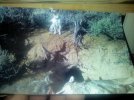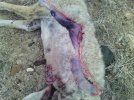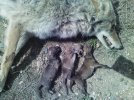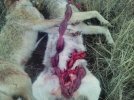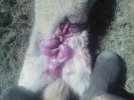Straight Shooter
Well-Known Member
Isn't mange in humans called scabies?
 Help Support Long Range Hunting Forum
Help Support Long Range Hunting Forum
I'm not sure about that. Might be. Both are burrowing mites, might be the same thing. They had covered mine and 3 other people's stomach/chest areas with a rough red rash, and man did it itch..Isn't mange in humans called scabies?
Very honorable thing to do for a suffering animal. I really believe that most animals know when you are there to help and know when we are there for other reasons. You have a friend for life there.This was him after about a month. I didn't name him for 2 months because I didn't think he was going to live. Now, 7 years later, he goes everywhere with me, and he filled out a little.. he's traveled with me for work since he was probably 6 months old..
He sleeps 2 feet from me all night long. He's the most loyal animal I've ever known. He cries if I leave him for very long, and he's very protective. A few months ago my wife was goofing around, punching me in the shoulder. He thought she was serious, so he launched himself from the floor to the other side of our California king bed and landed between us. He's never been allowed on the bed, so it was a big deal to him. I wanted to see what he would do, so i didn't say anything. He wedged himself between us and laid down. He's about 125lbs now.Very honorable thing to do for a suffering animal. I really believe that most animals know when you are there to help and know when we are there for other reasons. You have a friend for life there.
My wife is still mad at me for filling our house with mange mites 7 years ago, and giving her the mange. She still mentions it periodically. That woman can hold a grudge.Hecould , you are correct some forms of the mange mites will live on humans . It's the demodectic mange mite ( scabies ) the sarcoptic mange mite doesn't last long on humans . I looked it up on Medical News Today : Mange in Humans : Treatment , Symptoms and Outlook . An interesting article I hope to never stop learning . It's not very common here for the coyote to get the demodectic mange they normally get the sarcoptic mange and cats don't get that type of mange either , they normally get Notoedic mites . Treatments include the use of cortical steroids , ivermectin ,lindane, permethrin creams ect.
When I worked with Wildlife Services ( USDA) they gave me a book , Field Manual of Wildlife Diseases in the Southeastern United States 3rd edition by William R. Davidson . That has a lot of good info in it as to what types of diseases animals carry and can be transmitted to humans . It is interesting how many diseases have been introduced to the United States since I worked with them only 15 years ago . Any of us that are around animals both wildlife and domestic are exposed to far more diseases then we realize .
